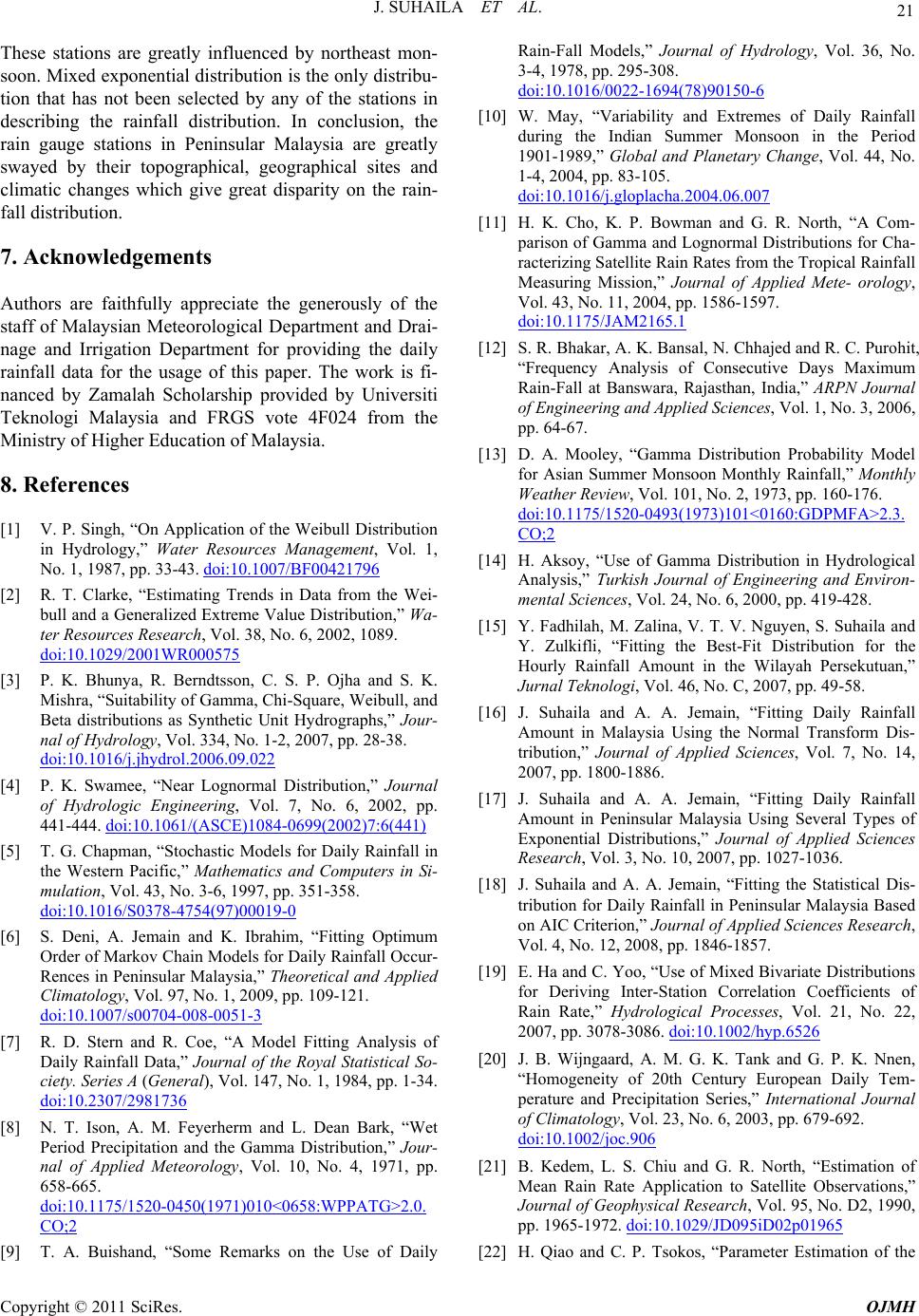
J. SUHAILA ET AL.
Copyright © 2011 SciRes. OJMH
21
These stations are greatly influenced by northeast mon-
soon. Mixed exponential distribution is the only distribu-
tion that has not been selected by any of the stations in
describing the rainfall distribution. In conclusion, the
rain gauge stations in Peninsular Malaysia are greatly
swayed by their topographical, geographical sites and
climatic changes which give great disparity on the rain-
fall distribution.
7. Acknowledgements
Authors are faithfully appreciate the generously of the
staff of Malaysian Meteorological Department and Drai-
nage and Irrigation Department for providing the daily
rainfall data for the usage of this paper. The work is fi-
nanced by Zamalah Scholarship provided by Universiti
Teknologi Malaysia and FRGS vote 4F024 from the
Ministry of Higher Education of Malaysia.
8. References
[1] V. P. Singh, “On Application of the Weibull Distribution
in Hydrology,” Water Resources Management, Vol. 1,
No. 1, 1987, pp. 33-43. doi:10.1007/BF00421796
[2] R. T. Clarke, “Estimating Trends in Data from the Wei-
bull and a Generalized Extreme Value Distribution,” Wa-
ter Resources Researc h, Vol. 38, No. 6, 2002, 1089.
doi:10.1029/2001WR000575
[3] P. K. Bhunya, R. Berndtsson, C. S. P. Ojha and S. K.
Mishra, “Suitability of Gamma, Chi-Square, Weibull, and
Beta distributions as Synthetic Unit Hydrographs,” Jour-
nal of Hydrology, Vol. 334, No. 1-2, 2007, pp. 28-38.
doi:10.1016/j.jhydrol.2006.09.022
[4] P. K. Swamee, “Near Lognormal Distribution,” Journal
of Hydrologic Engineering, Vol. 7, No. 6, 2002, pp.
441-444. doi:10.1061/(ASCE)1084-0699(2002)7:6(441)
[5] T. G. Chapman, “Stochastic Models for Daily Rainfall in
the Western Pacific,” Mathematics and Computers in Si-
mulation, Vol. 43, No. 3-6, 1997, pp. 351-358.
doi:10.1016/S0378-4754(97)00019-0
[6] S. Deni, A. Jemain and K. Ibrahim, “Fitting Optimum
Order of Markov Chain Models for Daily Rainfall Occur-
Rences in Peninsular Malaysia,” Theoretical and Applied
Climatology, Vol. 97, No. 1, 2009, pp. 109-121.
doi:10.1007/s00704-008-0051-3
[7] R. D. Stern and R. Coe, “A Model Fitting Analysis of
Daily Rainfall Data,” Journal of the Royal Statistical So-
ciety. Series A (General), Vol. 147, No. 1, 1984, pp. 1-34.
doi:10.2307/2981736
[8] N. T. Ison, A. M. Feyerherm and L. Dean Bark, “Wet
Period Precipitation and the Gamma Distribution,” Jour-
nal of Applied Meteorology, Vol. 10, No. 4, 1971, pp.
658-665.
doi:10.1175/1520-0450(1971)010<0658:WPPATG>2.0.
CO;2
[9] T. A. Buishand, “Some Remarks on the Use of Daily
Rain-Fall Models,” Journal of Hydrology, Vol. 36, No.
3-4, 1978, pp. 295-308.
doi:10.1016/0022-1694(78)90150-6
[10] W. May, “Variability and Extremes of Daily Rainfall
during the Indian Summer Monsoon in the Period
1901-1989,” Global and Planetary Change, Vol. 44, No.
1-4, 2004, pp. 83-105.
doi:10.1016/j.gloplacha.2004.06.007
[11] H. K. Cho, K. P. Bowman and G. R. North, “A Com-
parison of Gamma and Lognormal Distributions for Cha-
racterizing Satellite Rain Rates from the Tropical Rainfall
Measuring Mission,” Journal of Applied Mete- orology,
Vol. 43, No. 11, 2004, pp. 1586-1597.
doi:10.1175/JAM2165.1
[12] S. R. Bhakar, A. K. Bansal, N. Chhajed and R. C. Purohit,
“Frequency Analysis of Consecutive Days Maximum
Rain-Fall at Banswara, Rajasthan, India,” ARPN Journal
of Engineering and Applied Sciences, Vol. 1, No. 3, 2006,
pp. 64-67.
[13] D. A. Mooley, “Gamma Distribution Probability Model
for Asian Summer Monsoon Monthly Rainfall,” Monthly
Weather Review, Vol. 101, No. 2, 1973, pp. 160-176.
doi:10.1175/1520-0493(1973)101<0160:GDPMFA>2.3.
CO;2
[14] H. Aksoy, “Use of Gamma Distribution in Hydrological
Analysis,” Turkish Journal of Engineering and Environ-
mental Sciences, Vol. 24, No. 6, 2000, pp. 419-428.
[15] Y. Fadhilah, M. Zalina, V. T. V. Nguyen, S. Suhaila and
Y. Zulkifli, “Fitting the Best-Fit Distribution for the
Hourly Rainfall Amount in the Wilayah Persekutuan,”
Jurnal Teknologi, Vol. 46, No. C, 2007, pp. 49-58.
[16] J. Suhaila and A. A. Jemain, “Fitting Daily Rainfall
Amount in Malaysia Using the Normal Transform Dis-
tribution,” Journal of Applied Sciences, Vol. 7, No. 14,
2007, pp. 1800-1886.
[17] J. Suhaila and A. A. Jemain, “Fitting Daily Rainfall
Amount in Peninsular Malaysia Using Several Types of
Exponential Distributions,” Journal of Applied Sciences
Research, Vol. 3, No. 10, 2007, pp. 1027-1036.
[18] J. Suhaila and A. A. Jemain, “Fitting the Statistical Dis-
tribution for Daily Rainfall in Peninsular Malaysia Based
on AIC Criterion,” Journal of Applied Sciences Research,
Vol. 4, No. 12, 2008, pp. 1846-1857.
[19] E. Ha and C. Yoo, “Use of Mixed Bivariate Distributions
for Deriving Inter-Station Correlation Coefficients of
Rain Rate,” Hydrological Processes, Vol. 21, No. 22,
2007, pp. 3078-3086. doi:10.1002/hyp.6526
[20] J. B. Wijngaard, A. M. G. K. Tank and G. P. K. Nnen,
“Homogeneity of 20th Century European Daily Tem-
perature and Precipitation Series,” International Journal
of Climatology, Vol. 23, No. 6, 2003, pp. 679-692.
doi:10.1002/joc.906
[21] B. Kedem, L. S. Chiu and G. R. North, “Estimation of
Mean Rain Rate Application to Satellite Observations,”
Journal of Geophysical Research, Vol. 95, No. D2, 1990,
pp. 1965-1972. doi:10.1029/JD095iD02p01965
[22] H. Qiao and C. P. Tsokos, “Parameter Estimation of the